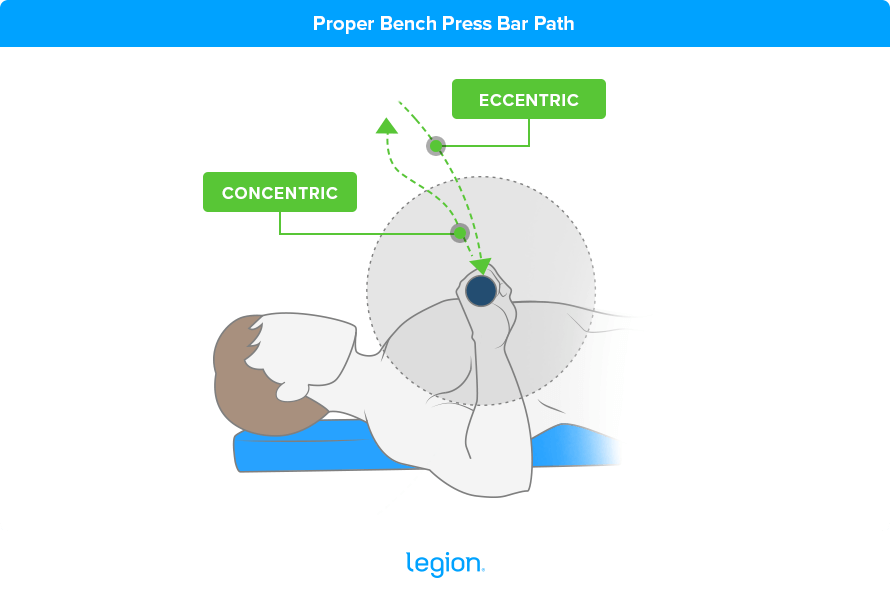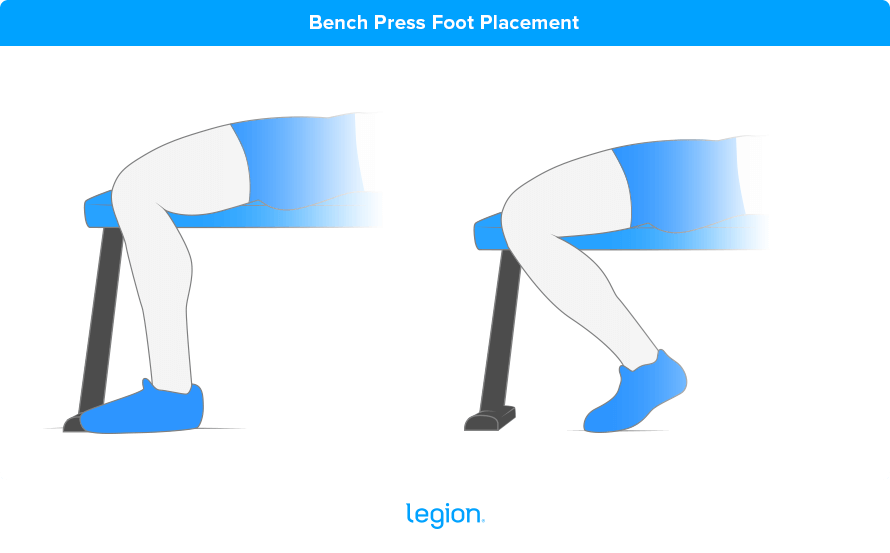If you’re serious about building muscle and strength, the bench press is likely a staple in your routine.
But, if you’re like most gymgoers, you’re probably overlooking a crucial bench press technique that can boost your performance and gains: leg drive.
What is bench press leg drive exactly?
Contrary to popular belief, proper leg drive doesn’t involve pushing your feet into the floor and squeezing your glutes to drive your hips upward.
Instead, leg drive is about using your legs to stabilize your body, generate extra power, and press more efficiently.
To get leg drive right, you need to understand how it works and how to apply it in your bench press setup.
And that’s exactly what you’ll learn in this article.
What Is Bench Press Leg Drive?
“Leg drive” is a weightlifting technique that involves using your legs to increase stability and generate power in the bench press.
The basic idea behind bench press leg drive is that as you press the bar upward, you drive your feet into the floor as if you were trying to slide your body up the bench (though your body doesn’t actually move because it’s pinned down by the weight in your hands).
Despite its potential to increase performance, many gymgoers neglect using leg drive, viewing it as an “advanced” technique reserved for powerlifters looking to press as much weight as possible.
While it’s true leg drive requires skill, it’s simpler to perform than most realize. And given that it can help you lift more weight safely, it’s a worthwhile technique for anyone looking to gain muscle and strength.
Why Is Leg Drive on the Bench Press Important?
The main benefit of using leg drive on the bench press is that it can help you lift more weight safely, which is significant because, generally speaking, the more weight you can lift, the more muscle and strength you gain.
Driving through your legs on the bench press achieves this in two ways:
- It increases whole-body stability.
- It helps you use a more efficient bar path.
Let’s discuss each in more detail.
Leg Drive Increases Whole-Body Stability
You may have heard that maintaining an arch in your back while benching is sensible, and this is true.
For most weightlifters, arching your spine to create a fist-sized gap between your back and the bench helps keep your shoulders safe and “tightens” your torso for extra stability.
There’s only one caveat: This is only true if you also use leg drive. If you arch without pushing through your legs, your setup actually becomes less stable.
Why?
Without bracing your body by pushing through your legs in the opposite direction to the descending barbell, the weight of the bar is usually enough to collapse your back arch and shift your torso out of position.
While these changes in posture and position are often minor (sometimes too small to notice), they decrease your overall stability and hinder your ability to press.
Driving through your legs, however, provides stronger foundations for your back arch, enabling your upper body to stay rigid, balanced, and stable, which helps you press more weight with a lower risk of injury.
Leg Drive Helps You Use a More Efficient Bar Path
Moving a barbell in a straight line from point A to point B is generally the most efficient way to lift weights.
For instance, to maximize your performance in the squat, deadlift, and overhead press, moving the bar in a straight line throughout each rep is paramount.
The bench press is different.
Trying to press the bar straight up and down over your chest creates a “moment arm” between your shoulder joint and the bar. This forces your muscles to work significantly harder and limits how much weight you can lift.
To counteract this, you need to correct your “bar path.” Here’s how:
- Begin with the bar directly over your shoulders.
- Lower the bar in a gentle arc to your lower chest.
- Press the bar up and toward your throat.
- Once the bar is over your shoulders again, finish the rep by pressing it straight up until your arms are straight.
Here’s a diagram to illustrate this:

Using an efficient bar path is possible without involving your legs, but it becomes significantly easier when you incorporate leg drive.
That’s because leg drive enables you to use your entire body to propel the barbell in the direction you want it to move (toward your throat), boosting how much you can lift.
How to Use Leg Drive in the Bench Press
Most gymgoers think leg drive means driving your feet into the floor to push your hips directly upward.
This is incorrect.
The purpose of leg drive is not to push your hips toward the ceiling—doing so increases the likelihood that your butt will lift off the bench, which reduces overall stability by removing one of your points of contact with the bench.
In competitive powerlifting, lifting your butt off the bench also invalidates your lift. While this isn’t an issue in a non-competitive setting, it still falls into the category of using “sloppy” form to lift extra weight, which, like half-squatting and round-back deadlifts, generally isn’t sensible.
To reap the benefits of leg drive, you must use your legs to push your body up the bench. In other words, think about driving through your legs to slide your body toward the top of the bench.
The diagram below illustrates this point. The picture on the left shows what not to do (drive your hips upward) and the picture on the right shows the direction your should be pushing:

Bench Press Foot Placement for Maximum Leg Drive
To use leg drive in the bench press effectively, you must first find the best foot position for you.
For most lifters, there are two options:
- Lie on the bench and position your feet flat on the floor shoulder-width apart or a little wider and turned slightly out. While keeping your soles flat on the floor, pull your feet toward your head until your heels feel like they’re beginning to lift. For most people, this will be when their feet are under the knees or slightly further back.
- Lie on the bench and pull your feet as far as you can under your body while still keeping your toes in contact with the floor.
Here’s how these foot placements look. Option one is on the left, and option two is one the right:

Option one allows you to produce the most leg drive and doesn’t require extreme flexibility, making it the best solution for most.
The benefit of option two is that it allows you to create a pronounced back arch. Some powerlifters prefer this because it can greatly reduce the distance the bar has to travel to complete a rep, allowing them to lift the maximum weight possible.
For most “lifestyle” weightlifters, however, it’s less stable and prevents you from producing as much leg drive as you otherwise could.
Timing Leg Drive
To maximize leg drive in the bench press, you need to master its timing. A good way to do this is to compare it to how you use your legs while squatting.
For instance, you use your legs to control the eccentric (lowering) phase of the squat without pushing against the weight. This changes at the bottom of each rep, when your legs drive against the bar to help you stand up.
Leg drive in the bench press follows a similar pattern.
As you lower the bar to your chest, your legs remain engaged to buttress your back arch and prevent your body shifting out of position. Once the bar touches your chest, you drive through your legs as hard as possible to heave the bar upward.
Bench Press Leg Drive: FAQs
FAQ #1: Is leg drive cheating?
No, leg drive isn’t cheating, provided you keep your butt on the bench. It’s a legitimate technique that many weightlifters use to stabilize their body and generate more power during the bench press.
FAQ #2: How much will using leg drive improve my bench press?
The impact of leg drive on your bench press depends on your current skill level and technique. Many novice weightlifters report that using leg drive allows them to lift significantly more weight because it improves their stability and helps them use a more efficient bar path.
If you already have a solid bench press setup and a smooth bar path, adding leg drive probably won’t produce dramatic gains. However, it can still offer a modest boost in your bench press performance and lower your risk of injury by improving stability, which should help you build more muscle and strength over time.
FAQ #3: Do bodybuilders use leg drive?
Some bodybuilders use leg drive in the bench press, though many find it hinders their “mind-muscle connection.” They may have a point, too—research suggests your pecs, shoulders, and triceps are ever-so-slightly more active when benching without leg drive (presumably because of the greater stabilization demands).
That’s not to say benching without leg drive leads to more muscle growth—muscle activation is often a lousy predictor of hypertrophy. But it does suggest that benching without leg drive is a valid approach for bodybuilders who prefer it. Just bear in mind that it likely means you’ll be able to handle less weight, which may limit the muscle-building potential of the exercise somewhat.
Scientific References +
- Van Every, Derrick W., et al. “Biomechanical, Anthropometric and Psychological Determinants of Barbell Bench Press Strength.” Sports, vol. 10, no. 12, 5 Dec. 2022, p. 199, https://doi.org/10.3390/sports10120199. Accessed 14 Feb. 2023.
- Kristiansen, M., et al. “Inter-Subject Variability of Muscle Synergies during Bench Press in Power Lifters and Untrained Individuals.” Scandinavian Journal of Medicine & Science in Sports, vol. 25, no. 1, 24 Dec. 2013, pp. 89–97, https://doi.org/10.1111/sms.12167.
- Chia, Justin . Leg-Drive Does Not Affect Upper Extremity Muscle Activation during a Bench Press Exercise. Mar. 2019, www.researchgate.net/publication/331535577_Leg-drive_Does_Not_Affect_Upper_Extremity_Muscle_Activation_during_a_Bench_Press_Exercise, https://doi.org/10.13189/saj.2019.070103.
- Vigotsky, Andrew D., et al. “Greater Electromyographic Responses Do Not Imply Greater Motor Unit Recruitment and “Hypertrophic Potential” Cannot Be Inferred.” Journal of Strength and Conditioning Research, vol. 31, no. 1, Jan. 2017, pp. e1–e4, https://doi.org/10.1519/jsc.0000000000001249.










